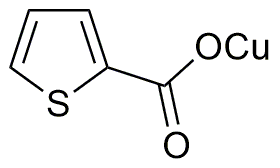Copper(I) thiophene-2-carboxylate is widely utilized in research focused on:
- Organic Electronics: This compound is used in the development of organic semiconductors, which are crucial for creating flexible and lightweight electronic devices, such as organic light-emitting diodes (OLEDs) and organic photovoltaic cells.
- Catalysis: It serves as a catalyst in various organic reactions, enhancing reaction rates and selectivity. This is particularly beneficial in the synthesis of complex organic molecules in pharmaceutical and fine chemical industries.
- Material Science: The compound is employed in the synthesis of advanced materials, including conductive polymers and nanocomposites, which are used in energy storage devices like batteries and supercapacitors.
- Environmental Applications: It has potential uses in environmental remediation processes, particularly in the removal of heavy metals from wastewater, providing a greener alternative to traditional methods.
- Research in Coordination Chemistry: This compound is a valuable tool for researchers studying coordination complexes, helping to advance the understanding of metal-ligand interactions and their applications in various fields.
General Information
Properties
Safety and Regulations
Applications
Copper(I) thiophene-2-carboxylate is widely utilized in research focused on:
- Organic Electronics: This compound is used in the development of organic semiconductors, which are crucial for creating flexible and lightweight electronic devices, such as organic light-emitting diodes (OLEDs) and organic photovoltaic cells.
- Catalysis: It serves as a catalyst in various organic reactions, enhancing reaction rates and selectivity. This is particularly beneficial in the synthesis of complex organic molecules in pharmaceutical and fine chemical industries.
- Material Science: The compound is employed in the synthesis of advanced materials, including conductive polymers and nanocomposites, which are used in energy storage devices like batteries and supercapacitors.
- Environmental Applications: It has potential uses in environmental remediation processes, particularly in the removal of heavy metals from wastewater, providing a greener alternative to traditional methods.
- Research in Coordination Chemistry: This compound is a valuable tool for researchers studying coordination complexes, helping to advance the understanding of metal-ligand interactions and their applications in various fields.
Documents
Safety Data Sheets (SDS)
The SDS provides comprehensive safety information on handling, storage, and disposal of the product.
Product Specification (PS)
The PS provides a comprehensive breakdown of the product’s properties, including chemical composition, physical state, purity, and storage requirements. It also details acceptable quality ranges and the product's intended applications.
Certificates of Analysis (COA)
Search for Certificates of Analysis (COA) by entering the products Lot Number. Lot and Batch Numbers can be found on a product’s label following the words ‘Lot’ or ‘Batch’.
*Catalog Number
*Lot Number
Certificates Of Origin (COO)
This COO confirms the country where the product was manufactured, and also details the materials and components used in it and whether it is derived from natural, synthetic, or other specific sources. This certificate may be required for customs, trade, and regulatory compliance.
*Catalog Number
*Lot Number
Safety Data Sheets (SDS)
The SDS provides comprehensive safety information on handling, storage, and disposal of the product.
DownloadProduct Specification (PS)
The PS provides a comprehensive breakdown of the product’s properties, including chemical composition, physical state, purity, and storage requirements. It also details acceptable quality ranges and the product's intended applications.
DownloadCertificates of Analysis (COA)
Search for Certificates of Analysis (COA) by entering the products Lot Number. Lot and Batch Numbers can be found on a product’s label following the words ‘Lot’ or ‘Batch’.
*Catalog Number
*Lot Number
Certificates Of Origin (COO)
This COO confirms the country where the product was manufactured, and also details the materials and components used in it and whether it is derived from natural, synthetic, or other specific sources. This certificate may be required for customs, trade, and regulatory compliance.


